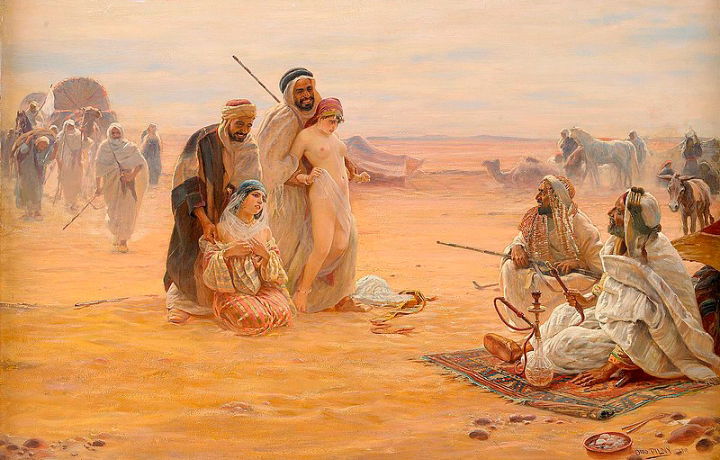How did Islamic kingdoms treat the societies, countries and citizens it defeated?


1. Non-Muslim Slaves & Muslim Masters
How did Islamic kingdoms treat the societies, countries and citizens it defeated? In this thread, we will understand the problem just by looking at a series of paintings depicting non-Muslim women under Islamic rule.
2. The painting is titled “The Slave Dealer” – painted in the year 1919 – by Otto Pilny, a Swiss artist. The slave dealer has just removed the clothes of the non-Muslim slave girl, showing her ‘wares’ to a rich Muslim prince.
3. “The Slave Market” – 1910 – Otto Pilny. A scene from the Arab-Turkish slave market is shown where non-Muslim slave women are sold like cattle in open market, completely naked!
4. “The Horse or the Slave” – Otto Pilny. A non-Muslim slave is paraded naked, for the same price as a horse, and the buyer has to choose between sexual pleasure or the convenience in transportation. (Most slave girls were from the Caucasus, Russia or other European countries)
5. “The Slave Market” – 1866 – Jean Leon Gerome, a French painter. This painting shows a white non-Muslim girl being sold in market, and the prospective Muslim buyers checking whether she has full teeth or not.
6. “Pool in a Harem” – 1875 – Jean Leon Gerome. A view inside an Islamic harem. Notice the sexual slaves who were always white girls from Europe. And the black slaves were used for menial jobs.
7. “Slave Market” – Fabio Fabbi, an Italian painter. Muslim traders are parading Greek women naked in market for buyers. So many Balkan, Russian girls were kidnapped in slave raids, that the very word ‘slave’ originates in ‘Slav’, the word for all the Slavic people.
8. “The Booty” – Fabio Fabbi. Muslim pirates displaying their non-Muslim ‘merchandise’, acquired in a typical raid, to a Muslim prince.
9. “Her Master’s Choice” – Fabio Fabbi. Non-Muslim slave girls for sale in Islamic slave markets.
Imagine being naked in a market where everyone else, including men, is overdressed.
10. “The Favorite” – Fabio Fabbi
11. “The Bitter Draught of Slavery” – 1885 – Ernest Normand – English Painter. One of the most evocative of all, this painting shows a slave trader urging hard to the very old Muslim chief to buy the white Christian slave for his harem. African slaves are used for menial labor.
12. “The Slave Merchant” – 1867 – Louis Devedeux. A Turkish chief inspecting the ‘wares’ of a half-naked Christian sex-slave.
13. “Sale of a Child Slave” – 1872 – Vasili Verschagin. One of the most devastating of all, this painting shows a naked child sold for sexual slavery in Central Asia (Turkestan), to a holy man of Islam.
14. ‘White slavery’ is a dirty secret of Islam. At the height of their powers Muslim countries were very fond of keeping white slave girls for sexual slavery. These raids were so frequent that Europe developed pirate tradition as a counter-balance to Islamic slave raids from sea.
15. Greece, Balkans, Russia, the Caucasus, Italy, Sicily, southern France, England, Scotland and even Iceland were raided for Christian slave girls and other booty by Islamic pirates originating from North Africa and Ottoman Empire. Entire coasts were depopulated due to this.
16. While Europe was raided for girls for sexual slavery, Africa was depopulated for black slaves for menial jobs. They were called ‘habshis’. And the Turks & Arabs were so racist that most of these black slaves were castrated so they could not even reproduce.
17. Holy Quran indicates slavery: (Chapter 33: Verse 50) O Prophet, We have made lawful for you your wives whose bridal dues you have paid, and the slave-girls you possess from among the prisoners of war, and the daughters of your paternal uncles and paternal aunts…
18. One of the most horrible chapters in the history of slave trading is the chapter of Islamic slavery of whites and blacks. When Europeans set out for Americas and India after Reconquista they actually took a leaf out of the Islamic book of slavery. Read this book to know more.
Credit – Pankaj Saxena
DISCLAIMER: The author is solely responsible for the views expressed in this article. The author carries the responsibility for citing and/or licensing of images utilized within the text.
